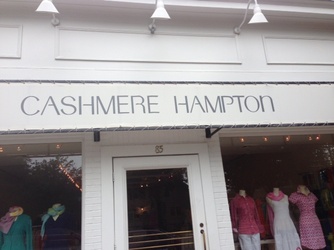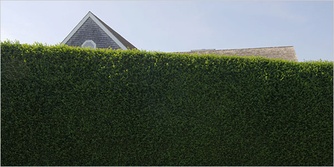Dispatches from the land of cashmere hedges....
In East Hampton, there is a store called Cashmere Hampton. For me that says it all. That, and the hedges.
Cashmere is the most luxurious of fabrics, an indulgence for much of the world but nothing special or unusual for the tribe I study and live among in Manhattan and out here in the Hamptons, site of their annual summer migration. And the hedges....you could write a book on these symbols of the Hamptons. Some people have. Well, articles, at least. Here's a fun one. And another. Mostly, once they no longer served to protect us from wild animals and potentially dangerous, uninvited human guests, hedges have been read as symbols of exclusivity and exclusion. "You can't see me. Or my house. Stay away!" The ubiquitous hedges of the East End — also called "privets" both here and in England — are usually thought to be something like the cashmere of foliages, a way to wrap yourself up and keep yourself apart from the rest of the world at a steep price.
Maybe. I see the hedges another way, too: as a version of who we are and an indication of what made us that way. In our evolutionary prehistory we were foragers, living in relatively small groups separated by great distances. With the advent of agriculture and then city life came new forms of community and proximity. And new perils. Property, warfare and especially disease. Lots and lots of disease that could thrive in the garbage and excrement we left to fester near us in unprecedented concentration in our communities. And lots of death. Being close to others has always been a double-edge sword for homo sapiens. Too little and you lose your mind and your life, an outcast among those who wander. Too much and you get dysentary and the plague and worse.
I like to think of the hedges of the Hamptons as a throwback to our earliest and most primitive issues and anxieties, and a deep comfort to us insofar as they help us grapple with and even resolve them. Hedges are an ingenious way we as a species can negotiate a huge and crucial human problem with historic and prehistoric roots — how to balance proximity and isolation, sociality and privacy. Too much or too little of any of these realities is deadly. But in just the right combination, they are like ambrosia for the minds and bodies of higher-order primates like us.
Looking out on a rolling green lawn, we probably feel the way a baboon feels sitting in a tree on the savannah — "If there are any bad guys out there, I can see them. Phew." Hedges further enhance that security, forming a neat little boundary to this contained version of a potentially dangerous world we can survey from a safe purchase.
And sure, they keep out prying eyes. But they do so much more. They symbolize culture, the way we have brought nature in line (literally) for our purposes. And hedges are arguably as much about connection as they are about cocooning. A hedge says, "I'm here and I'm near to my neighbor in a way I can tolerate." All while giving us a reassuring shot of confidence that we can bend the natural world to suit our agendas, rather than simply be subject to it. In their melding of nature and culture, in their blending of isolation and community, the cashmere hedges of the Hamptons, like hedges everywhere, reflect back a version of ourselves. In hedges, we feel our vulnerability and see "proof" of our victory over it. We feel together and alone — in just the right balance. Is it any wonder, then, that hedges out here cost a lot?

